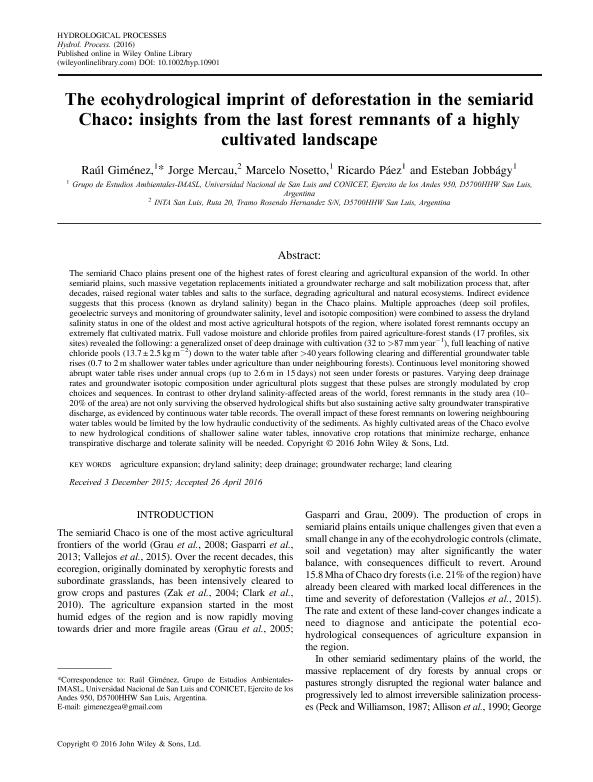Artículo
The ecohydrological imprint of deforestation in the semiarid Chaco: insights from the last forest remnants of a highly cultivated landscape
Giménez, Raúl ; Mercau, Jorge Luis; Nosetto, Marcelo Daniel
; Mercau, Jorge Luis; Nosetto, Marcelo Daniel ; Paez, Ricardo Andrés
; Paez, Ricardo Andrés ; Jobbagy Gampel, Esteban Gabriel
; Jobbagy Gampel, Esteban Gabriel
 ; Mercau, Jorge Luis; Nosetto, Marcelo Daniel
; Mercau, Jorge Luis; Nosetto, Marcelo Daniel ; Paez, Ricardo Andrés
; Paez, Ricardo Andrés ; Jobbagy Gampel, Esteban Gabriel
; Jobbagy Gampel, Esteban Gabriel
Fecha de publicación:
07/2016
Editorial:
John Wiley & Sons Ltd
Revista:
Hydrological Processes
ISSN:
0885-6087
Idioma:
Inglés
Tipo de recurso:
Artículo publicado
Clasificación temática:
Resumen
The semiarid Chaco plains present one of the highest rates of forest clearing and agricultural expansion of the world. In other semiarid plains, such massive vegetation replacements initiated a groundwater recharge and salt mobilization process that, after decades, raised regional water tables and salts to the surface, degrading agricultural and natural ecosystems. Indirect evidence suggests that this process (known as dryland salinity) began in the Chaco plains. Multiple approaches (deep soil profiles, geoelectric surveys and monitoring of groundwater salinity, level and isotopic composition) were combined to assess the dryland salinity status in one of the oldest and most active agricultural hotspots of the region, where isolated forest remnants occupy an extremely flat cultivated matrix. Full vadose moisture and chloride profiles from paired agriculture-forest stands (17 profiles, six sites) revealed the following: a generalized onset of deep drainage with cultivation (32 to >87 mm year−1), full leaching of native chloride pools (13.7 ± 2.5 kg m−2) down to the water table after >40 years following clearing and differential groundwater table rises (0.7 to 2 m shallower water tables under agriculture than under neighbouring forests). Continuous level monitoring showed abrupt water table rises under annual crops (up to 2.6 m in 15 days) not seen under forests or pastures. Varying deep drainage rates and groundwater isotopic composition under agricultural plots suggest that these pulses are strongly modulated by crop choices and sequences. In contrast to other dryland salinity-affected areas of the world, forest remnants in the study area (10–20% of the area) are not only surviving the observed hydrological shifts but also sustaining active salty groundwater transpirative discharge, as evidenced by continuous water table records. The overall impact of these forest remnants on lowering neighbouring water tables would be limited by the low hydraulic conductivity of the sediments. As highly cultivated areas of the Chaco evolve to new hydrological conditions of shallower saline water tables, innovative crop rotations that minimize recharge, enhance transpirative discharge and tolerate salinity will be needed.
Archivos asociados
Licencia
Identificadores
Colecciones
Articulos(IMASL)
Articulos de INST. DE MATEMATICA APLICADA DE SAN LUIS
Articulos de INST. DE MATEMATICA APLICADA DE SAN LUIS
Citación
Giménez, Raúl; Mercau, Jorge Luis; Nosetto, Marcelo Daniel; Paez, Ricardo Andrés; Jobbagy Gampel, Esteban Gabriel; The ecohydrological imprint of deforestation in the semiarid Chaco: insights from the last forest remnants of a highly cultivated landscape; John Wiley & Sons Ltd; Hydrological Processes; 30; 15; 7-2016; 2603-2616
Compartir
Altmétricas



